How to write the best email subject lines and boost engagement

An email subject line is kind of like that first meeting with your friend’s cat—hear me out! It needs to be relaxed and inviting to entice the reader to open your message. If you come in too excited and pushy, you’ll scare Fluffy away.
Email subject lines are the first thing recipients see when they receive your email, and this messaging plays a major role in determining whether or not the email gets opened.
A great email subject line, along with the preheader text, should grab the reader’s attention, provide a hint of what’s inside and motivate the reader to take action. So, if you want your emails to be read, optimizing your email subject lines is essential.
We’ve identified three guiding principles to help you write your best email subject lines:
Personalize it
Make it relevant
Test to optimize
In this guide, we’ll show you how to optimize your email subject lines, and provide professional email subject line examples that will help you boost your open rate. Me-ow!
Professional email subject line examples to inspire you
We searched millions of emails to find effective email subject lines. These lines were chosen because they had exceptional open rates. While the content is specific to someone else’s newsletters, you can see what works for them and apply it to your own topics.
I got ANOTHER sweet clean FREEBIE for you!
This is not another boring email, {$name|default:"friend"}! It's good news!
[Freebie Friday] So many secrets…
Welcome to your next escape
I have a feeling YOU will love this!
Happy Friday + Surprise Inside!?
Are you an early bird?
Did you invest in a financial product that wasn't great?
There are literally 101 free books in this email
Life happens. And so do giveaways.
Mother nature just doesn't want to cooperate with us! ⚽
I'm a stunningly bad businessperson.
Join me on the magic GDPR carpet ride... (Okay, it's not magic, but I do have to send this email.)
Cyber Week - Get your one-click finger ready
It's about dang time!
Sometimes you just need to vent (literally)
Hold onto your seat, cross your legs, and wait for the laughs.
NO, THIS ISN'T TURNING INTO A FOOD BLOG..HAHA
The Good, the Bad and the...I can't think of something funny, I need a nap
GDPR ≠ Gosh Darn Pretzel Rolls
We are so Thankful for YOU
Thank You for Saying YES!
Dearest,{$name} Thank You for your love and support on my New Novel!
Thank you for sticking with me! Check inside for a special giveaway!
★★★ Thanks for subscribing! Open to get your gift! ★★★
Poll Results and Thank You Bonuses! (LOTS of goodies inside!)
Thank You for Being Amazing!
Here's a little thank you present for sticking with me…
Thanks for signing up! Attention required so you don't miss a thing!
Welcome! Here's a little FREEBIE to say thank you for joining the fun!
We Would Love to Know Your Thoughts
Do you still want to receive news and updates from me?
How Much Did YOU Love My Present?
{$name}❤ What Did You Think Of The Wolf's Lover?
We want to stay in touch - Action needed
⏳✉? When do you want to hear from me?
Following up on today’s webinar
Thank You & Next Steps
{$name}, quick follow-up
Quick follow-up regarding Cookbook, plus a few little extras!
⚡ Sizzling Summer Releases and Hot Deals ⚡
A Special Coupon Just For You!
Not a newsletter but FLASH SALE!
Sold out in 30 min but wait, there is hope!
Alright, screw it, distro sale is 35% off and ends tonight!
{$name}, It's Bonus Sale day!
Sales and freebies everywhere!
A DIRTY SALE, {$name|default:"friends"}!
Who doesn't love a sale?
Holiday sale! Yup, I've got something FREE for you!
Download-Binge-Repeat: Last Chance Box Sets and a Fantasy Book Deal
LAST CHANCE! ⚔Get The Knight's Reward at its special launch price!
Don't let this chance pass you by, {$name|default:"friends"}!
LAST CHANCE! Freebies will be gone tonight!?
❤️ Share your recipe... and last chance to enter...❤️
Last chance to get it {$name}
⏩ Don't Miss These Events from Wildfire Marketing!
Time is flying....Don't miss out on a good deal
Today is the Day! [don't miss this deal]
It's decision time... Don't miss this
I've had this in my closet for over 10 years
(Mostly) Good News!!
Another one bites the dust
We did the thing
Now, this is just getting weird…
I could NOT contain my excitement...
It felt like a good idea at the time…
The Ten-Minute Project That's SO WORTH IT
Dear {$name|default:"Reader"}, I've never done this before.
So we did something crazy
Welcome Gift!
welcome, {$name|default:"new friend"}! I have exciting news inside.
Welcome to Day 1 of the 7 Days of Play Email Challenge - So Why Play Anyways??
❤ Welcome To The Start Of A Beautiful Friendship ❤
{$name}, welcome to Eve Silver's VIP Reader Group! Thanks for signing up.
Welcome!? Here's a little FREEBIE to say thank you for joining the fun!?
WELCOME AND FREE STUFF FOR YOU
A Welcome Gift! My #1 Wall Street Journal Bestseller is Free Inside
Hi, and welcome to my tribe! (You're going to want to open this!)
Thank You For Joining The Mailing List!
Subject line data analysis
Our data scientist analyzed millions of email marketing campaigns to unearth new insights about effective subject lines. Here’s what he found:
Subject line keywords that convert
These are keywords used in subject lines that tend to repeat in well-performing campaigns.
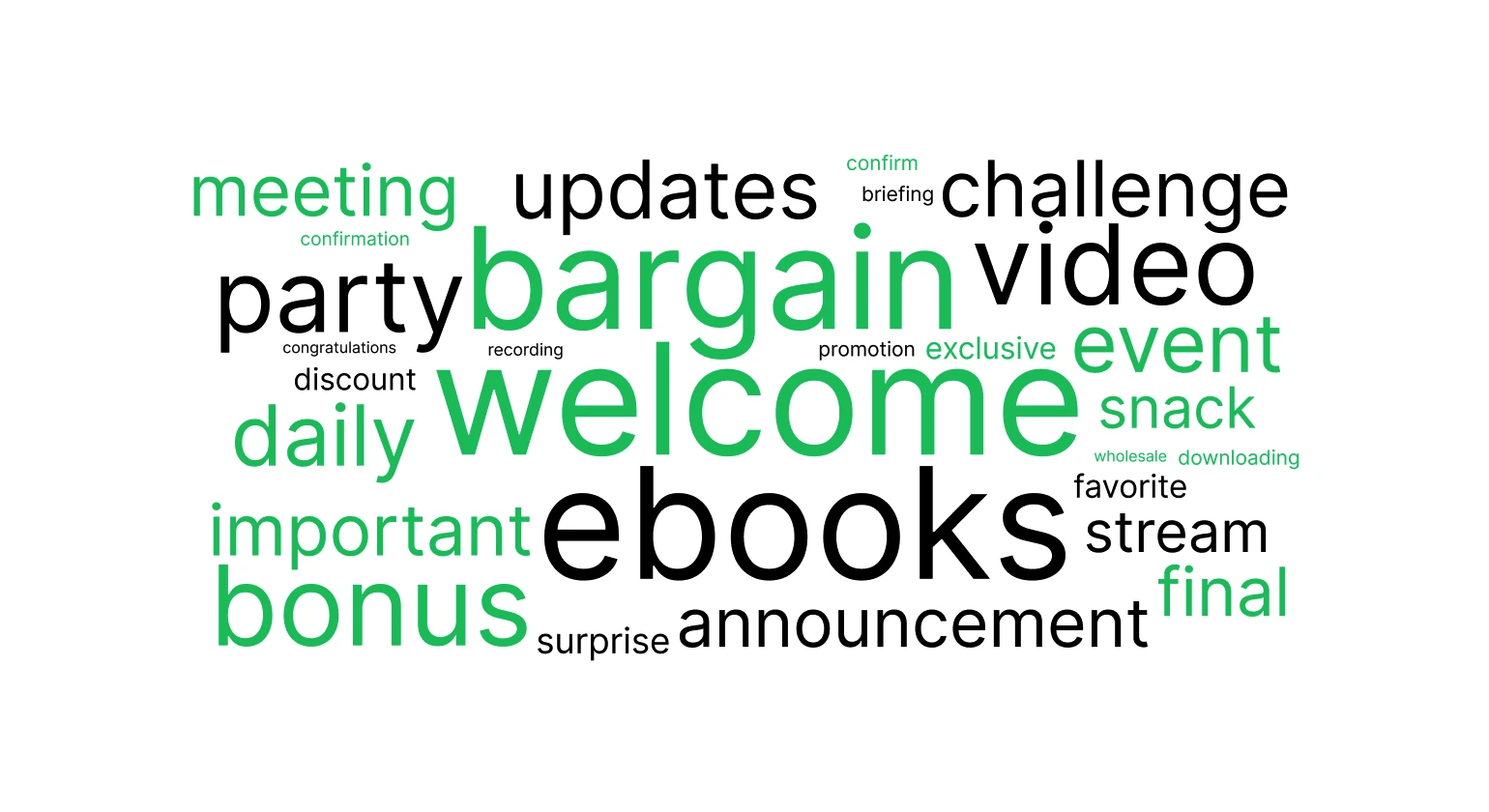
High-performing keywords: “welcome”, “ebooks”, “bargain”, “video”, “bonus”, “party”, “daily”, “updates”, “event”, “challenge”, “important”, “surprise”, “meeting”, “announcement”, “final”, “favorite”, “exclusive”, “discount”, “stream”, “confirmation”, “requirements”, “premiere”, “briefing”, “confirm”, “promotion”, “downloading”, “recording”, “congratulations”.
Takeaway: Welcome/confirmation emails perform exceptionally well, make them count!
This chart shows open rates when using keywords associated with dates.
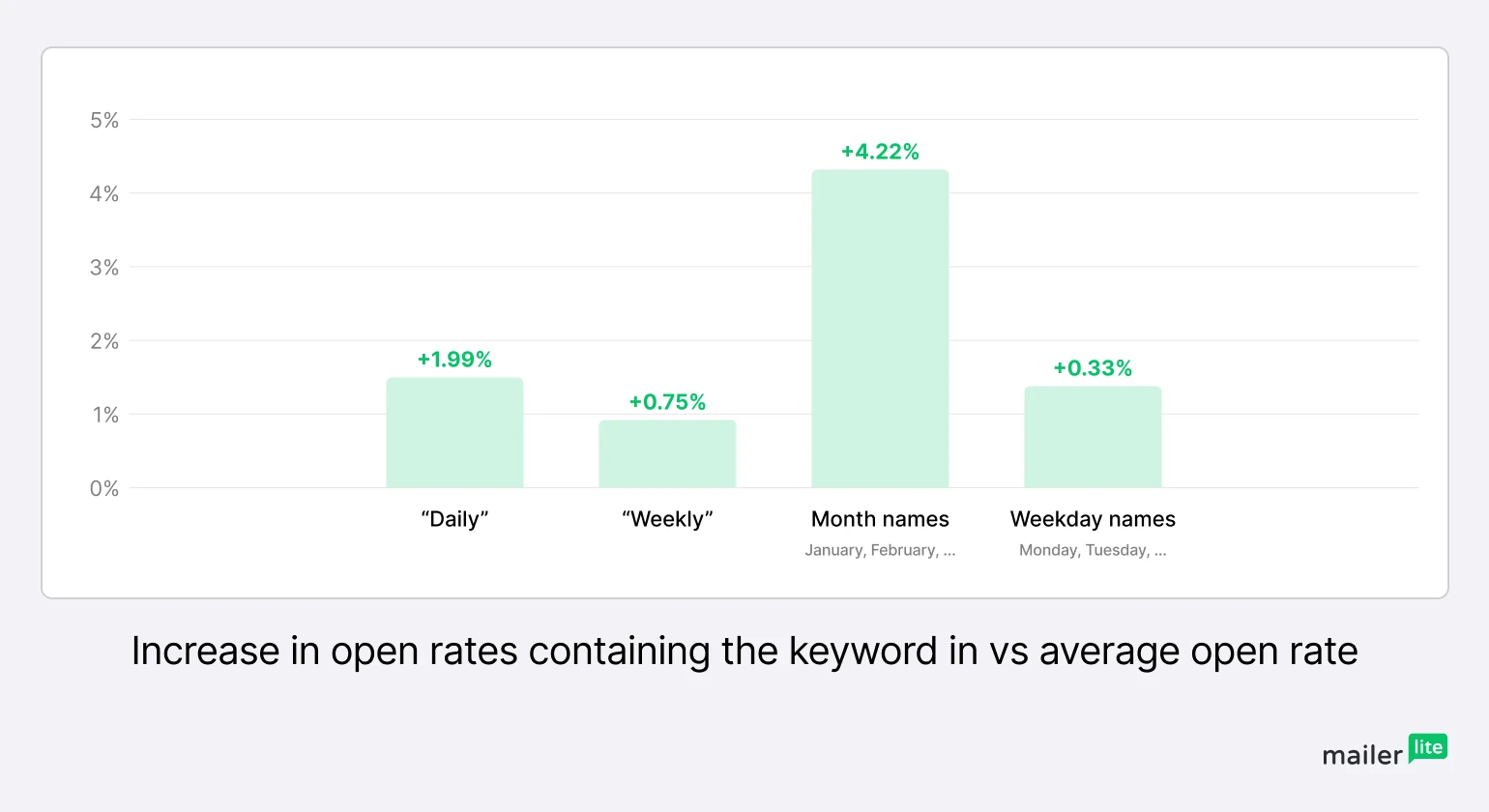
Poorly-performing subject line keywords
These keywords that raise a sense of urgency tend to repeat in very poorly-performing email campaigns.
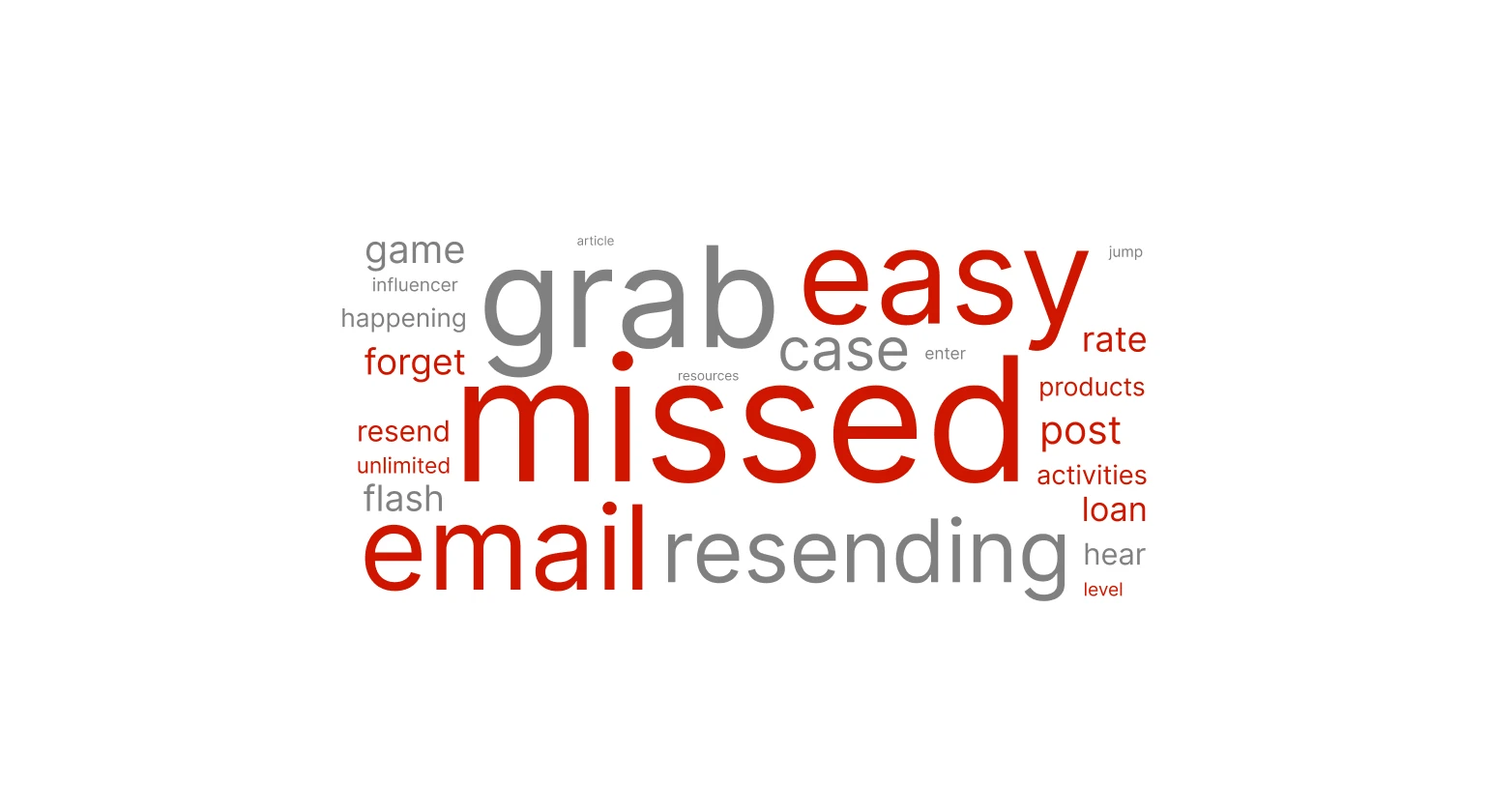
Subject line keywords that don't perform as well: “missed”, “grab”, “easy”, “case”, “email”, “resending”, “post”, “game”, “forget”, “flash”, “rate”, “enter”, “loan”, “resend”, “resources”, “activities”, “article”, “unlimited”, “career”, “level”, “influencer”, “wicked”, “jump”
Takeaway: If you’re resending a campaign, don’t tell subscribers in the subject line that you’re resending them recycled content. Get creative and encourage them to open with a subject line that’s more likely to convert
Subject lines with numbers
We’ve also found that open rates are affected when numbers are used in the email subject line.
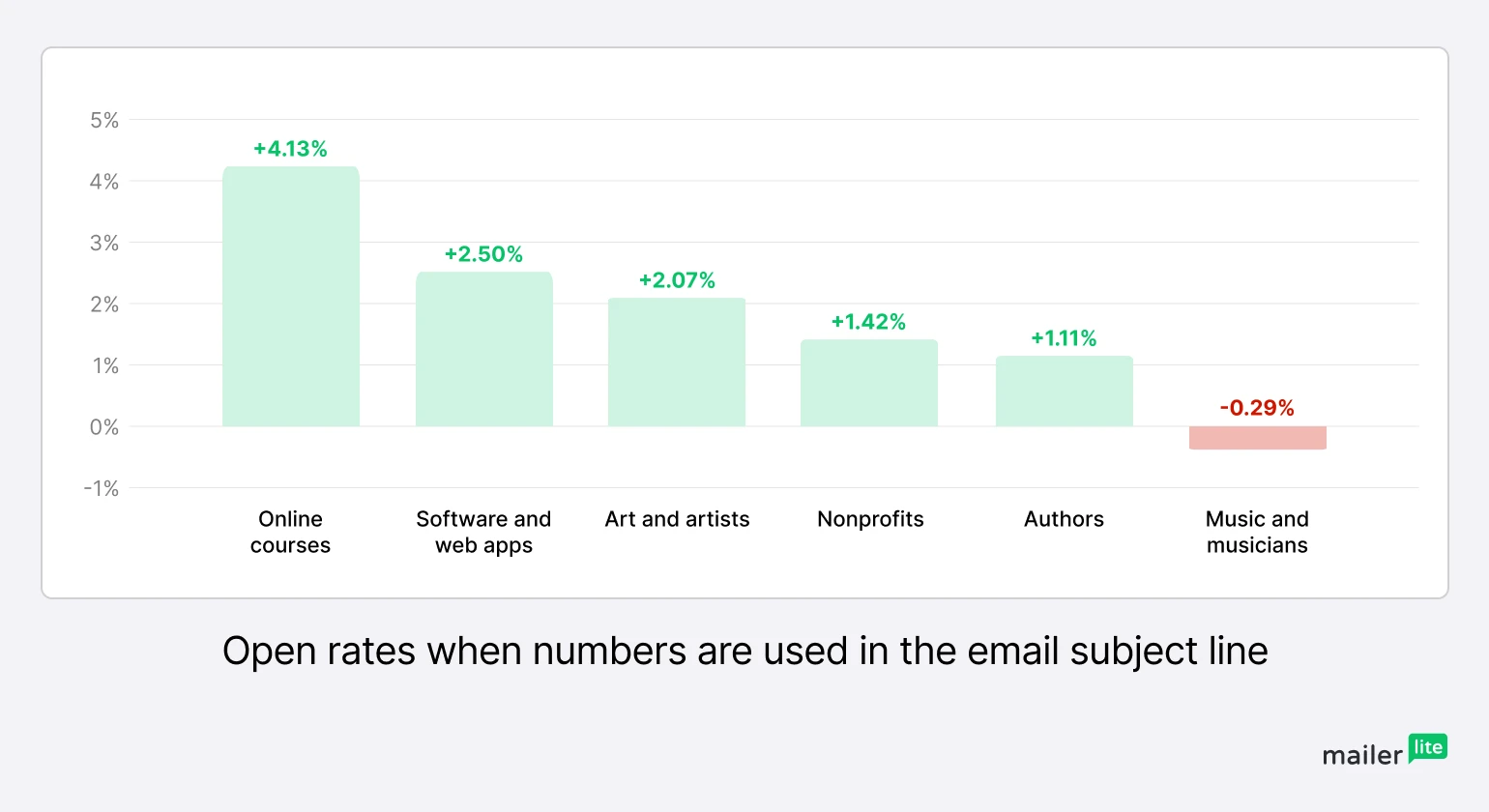
Takeaway: Numbers can increase open rates if used properly and for certain industries. See below.
Numbers help these industries: Open rate significantly increased (by 2% or more) for Online courses, Automotive, Software and web apps, Information technology (IT), Politics, Art and Artists when numbers were used in the subject line
Numbers don't help these industries: Open rates are decreased for Galleries, Museums, Mobile industries, Music and Musicians when numbers were used in the subject line
16 tips for writing email subject lines that work
1. Tell readers what your email is about
It might sound like obvious advice, but it bears mentioning. You’d be surprised how many people forget to even elude to what their email newsletter contains.
You want to tease the content in your subject line to pique interest and encourage subscribers to read more. If you’re too vague, there’s no incentive to open and take action.
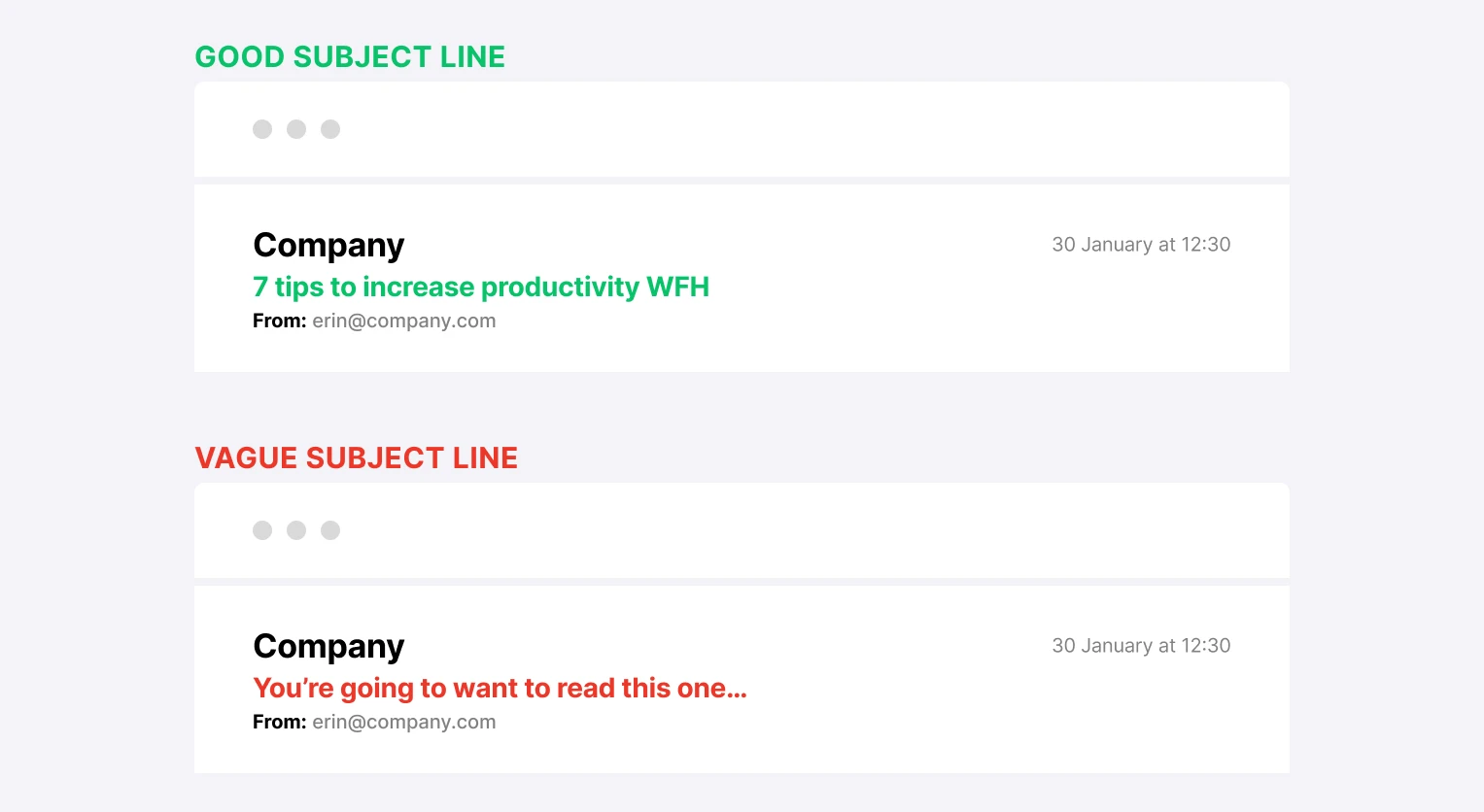
In the first example above, it’s clear what the reader will gain from opening the email. The second example makes an attempt to generate FOMO but neglects to include any hint as to what the benefit of reading is.
2. Insert your reader’s name
When a reader sees their name in a personalized email subject line, something happens in their brain where they need to see what it is. This level of personalization is personalization is easy to implement easy to implement and available to every MailerLite user.

Note: Personalized subject lines can generate great results, but you have to be careful NOT to use them every time you send an email. Too much will lessen the effect until the reader starts ignoring it.
3. Use AI for inspiration
Coming up with clever subject lines isn't easy. If you're stuck for inspiration about what to include, use AI to write crafty copy for you. You can use the generated content as is, or edit it to create a subject line that's sure to wow your subscribers.
Using AI to create subject lines is more convenient than ever thanks to our new AI subject line generator, which you can find in the email details section of a campaign or automation. Just describe what the email is about, choose a tone and email type, then hit generate. The tool will suggest 5 different options for you to use.
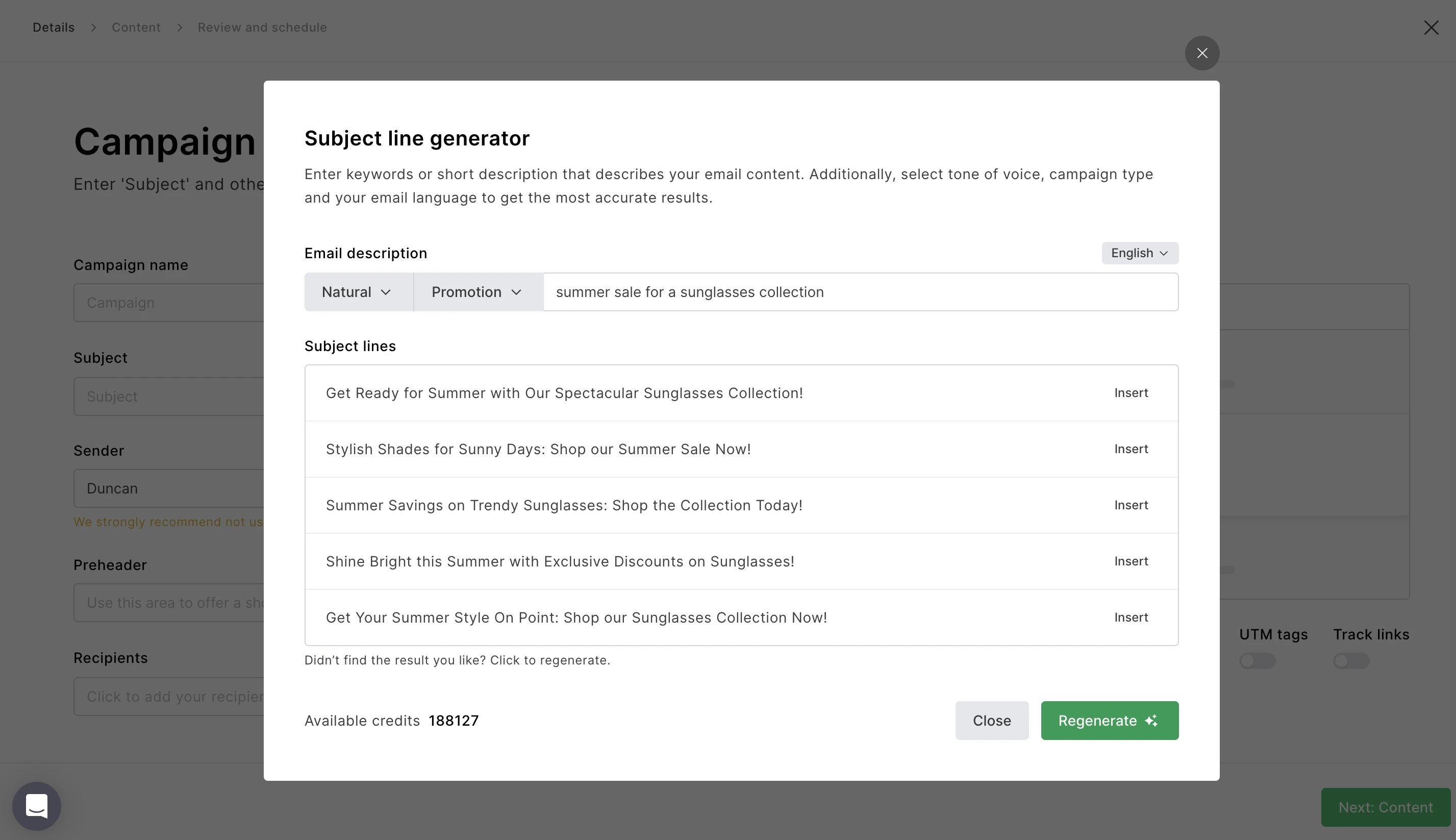
4. Personalize the sender address
The first two things people look at in their inbox are the subject line and the sender's name. Use a familiar name. If possible, send the email from a real person.
You don’t care what is the subject line of the email you received from your mom, right? That’s the point. We usually open and read emails that are sent by someone we trust and know.
For example, 'Jonas from MailerLite' works well because the reader will recognize the company and the name adds a personal touch.

When an email is sent from a familiar sender, opening rates increase by as much as 28%. In a world of endless spam and email bots, personalizing your sender address breaks through the inbox clutter.
5. Refer to your reader's location.
People feel a connection to their hometown. When you include location-specific language in the subject line, your readers will be curious about what is happening in their area.

6. Highlight your reader's interests.
If you have collected data on your users, find ways to connect with them through their interests. For example, you can segment your audience by their favorite sports team.

By calling out something meaningful to your email recipients in the subject line, they are more likely to open the email.
7. Make it relevant
Email marketing that is relevant means sending the right messages to the right people. Tailor your content to your reader’s interests and desires.
Instead of blasting out an email to your entire email list, you can increase relevance by segmenting your audience into smaller groups. When you send emails to smaller portions of your list, you can get more specific based on that group's interests or needs.
To be truly relevant, you need to be specific and descriptive in your copy. Don't be tempted to use catchy phrases or click bait to get higher open rates.
Not only are readers turned off, but it also indicates that your content is not relevant enough to explain it simply.
Which headline is more descriptive?
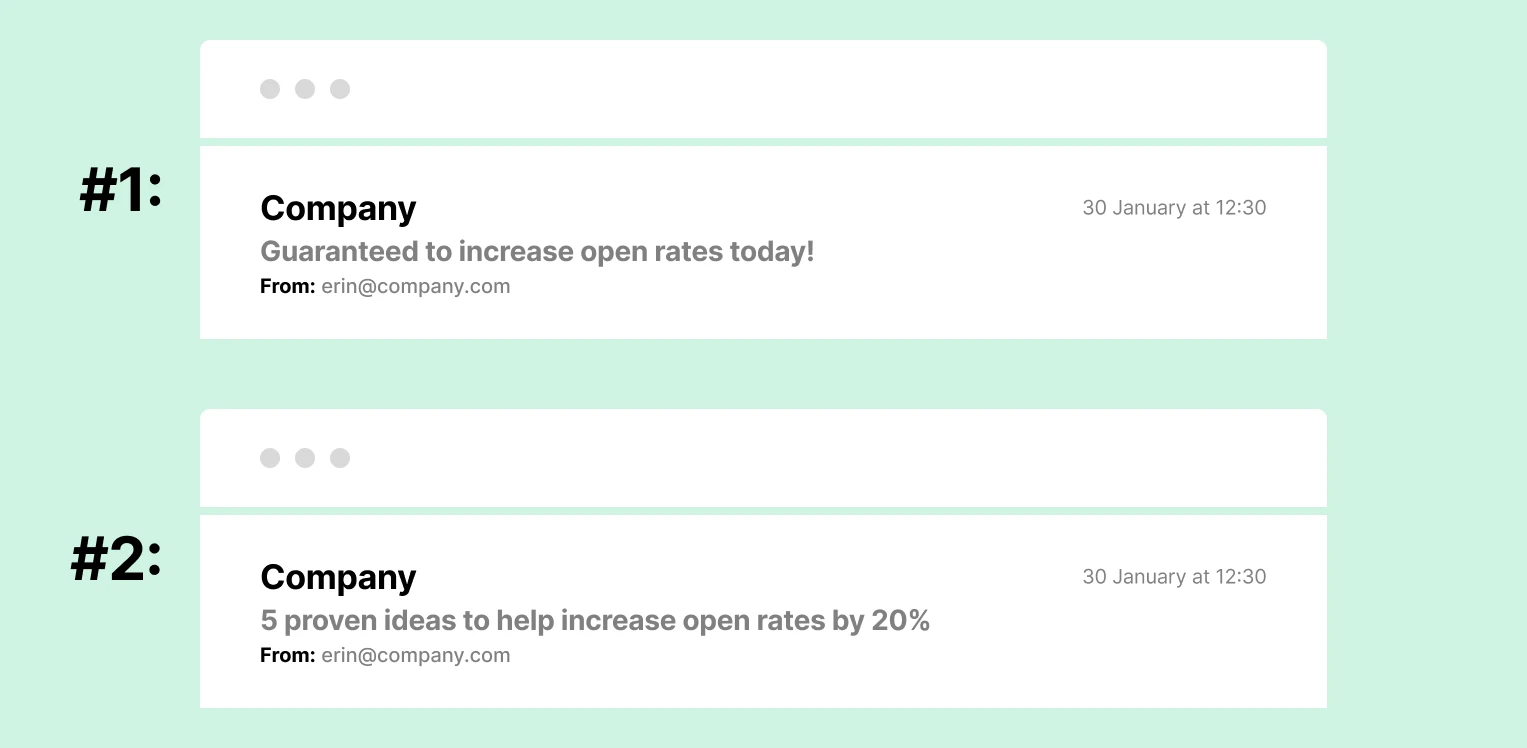
Subject line #1 is not very descriptive and makes a big claim with nothing to support it. On the other hand, line #2 lets the reader know exactly what to expect in the email.
People have dozens of emails to filter through. Get to the point quickly!
The best subject lines make a promise and then deliver on that promise. Of course, your content must deliver on the promise, or your bounce rate will go through the roof.
Tip: You can also increase relevance by implementing automation triggers to target subscribers based on how they interact with your content.
8. Avoid looking like spam
Don't use spammy phrases that sound too salesy or make promises you can't keep. Readers are savvy to clickbait and will immediately mark your email as spam. Do your best to minimize exclamation points or CAPS. People are usually not as excited as you are about your email. In fact, our data found that subject lines that insist on urgency perform much worse.
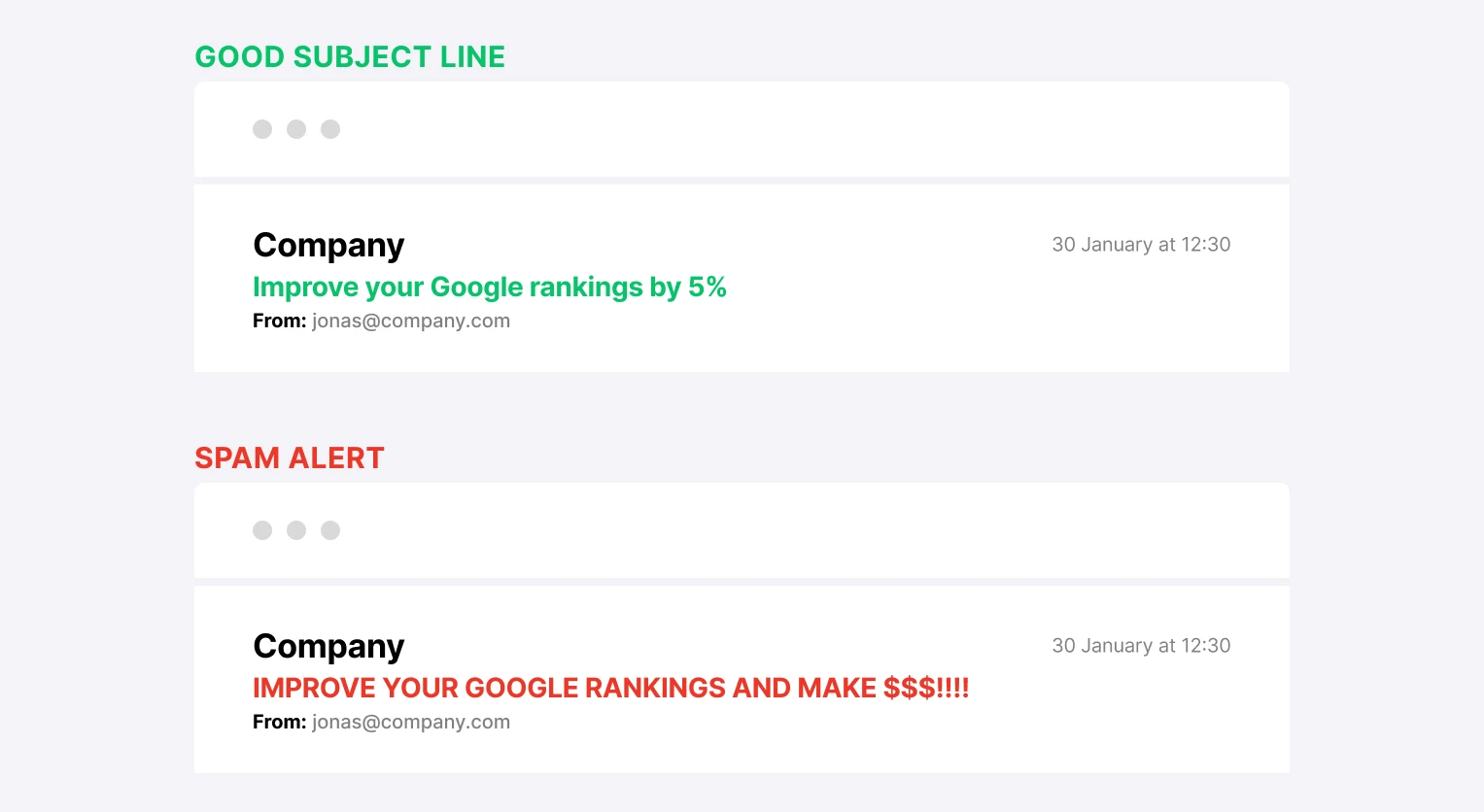
9. Consider responsive mobile display
Over half of your subscribers are viewing emails on mobile devices. The subject line parameters change with mobile. iPhone cuts off subject lines after 35 characters but gives 140 characters of preheader. Keep your subject lines under 40 characters to ensure it's readable on every device.
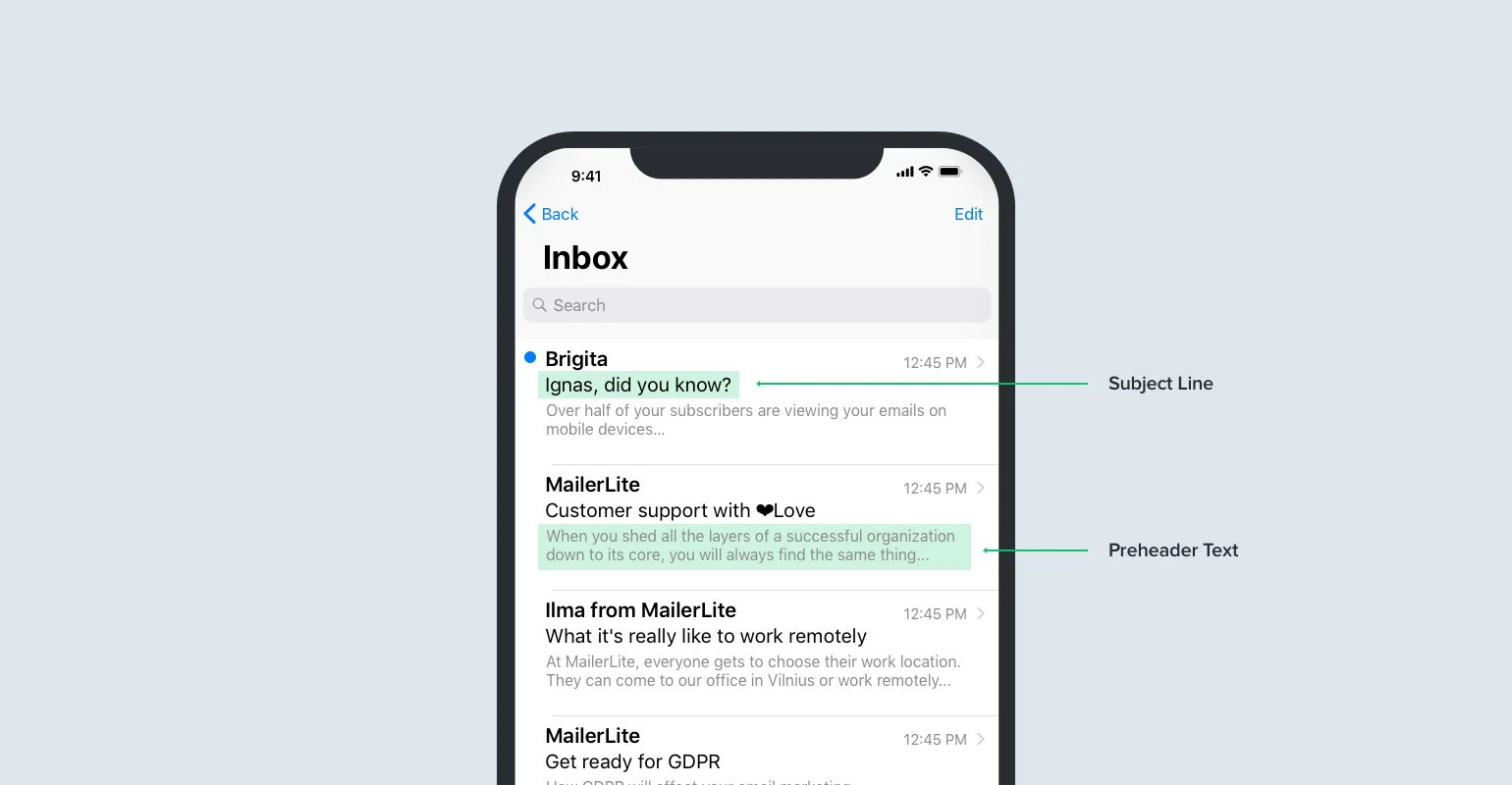
10. Ask a question
People like answering questions. Questions draw the reader into the conversation as a participant. Try subject lines that pose a question to pique curiosity. Your email open rates are likely to increase as people naturally want to find answers.

11. Use numbers and lists
For some reason, people love to click on emails with numbers and lists. Perhaps it's because their expectations are clearly defined or it's easier for the brain to process. Whatever the reason, numbers and lists have been proven to work. Our 2020 data shows email subject lines using numbers generate a 24.97% open rate versus 23.34% without using numbers.

12. Leverage scarcity
Have you ever noticed how Apple sells out of their newest products forcing most to wait? Apple has mastered the scarcity principle, where the value rises when demand is greater than supply. You can use this same strategy in your subject line. Let readers know that your offer is limited or has an expiration date.

13. Experiment with emojis
In some industries, emojis are a total hit. Research and testing have shown that emojis can increase open rates and click-through rates, make your email stand out, and give your brand some personality.
But emojis don’t always translate. Some email marketers find that emojis can drastically decrease email metrics. To find out if emojis work for your audience, A/B test your subject lines with and without emojis.
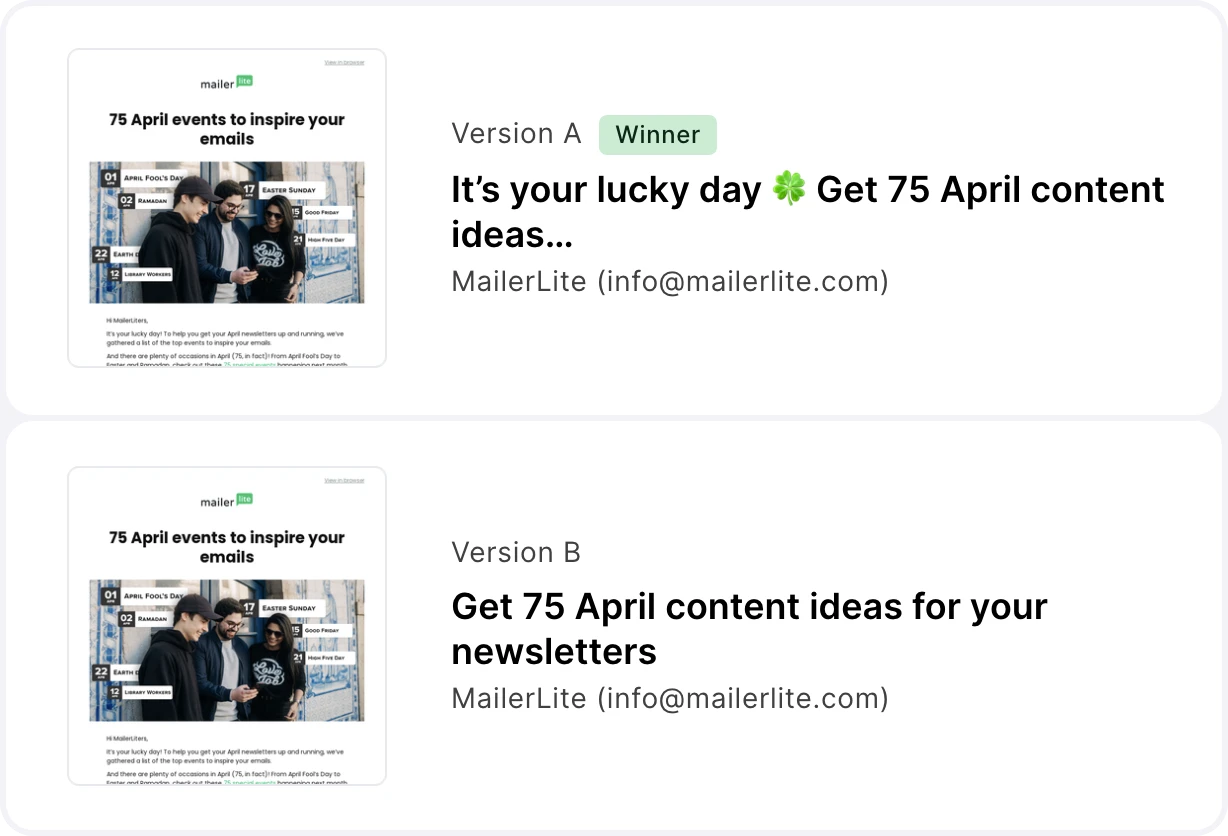
We actually looked at 48 industries and compared the open rates of newsletters that included emojis in subject lines versus those that did not. Check out the results in our complete guide to using emojis in subject lines.
14. Use preheaders to your advantage
The preheader is your subject line's best friend. It's the first line of text that appears next to the subject line. This is especially important for mobile devices where the preheader is often more prominent than the subject line.
For example, iPhone only allows 35 characters for a subject line, but displays about 140 characters for the preheader. That is a full tweet! (Well, an old tweet before Twitter increased it to 280 characters).
Preheaders provide an additional opportunity to increase your open and click-through rates.
Seize the opportunity to include compelling text that communicates your value proposition and motivates your readers to open the email.
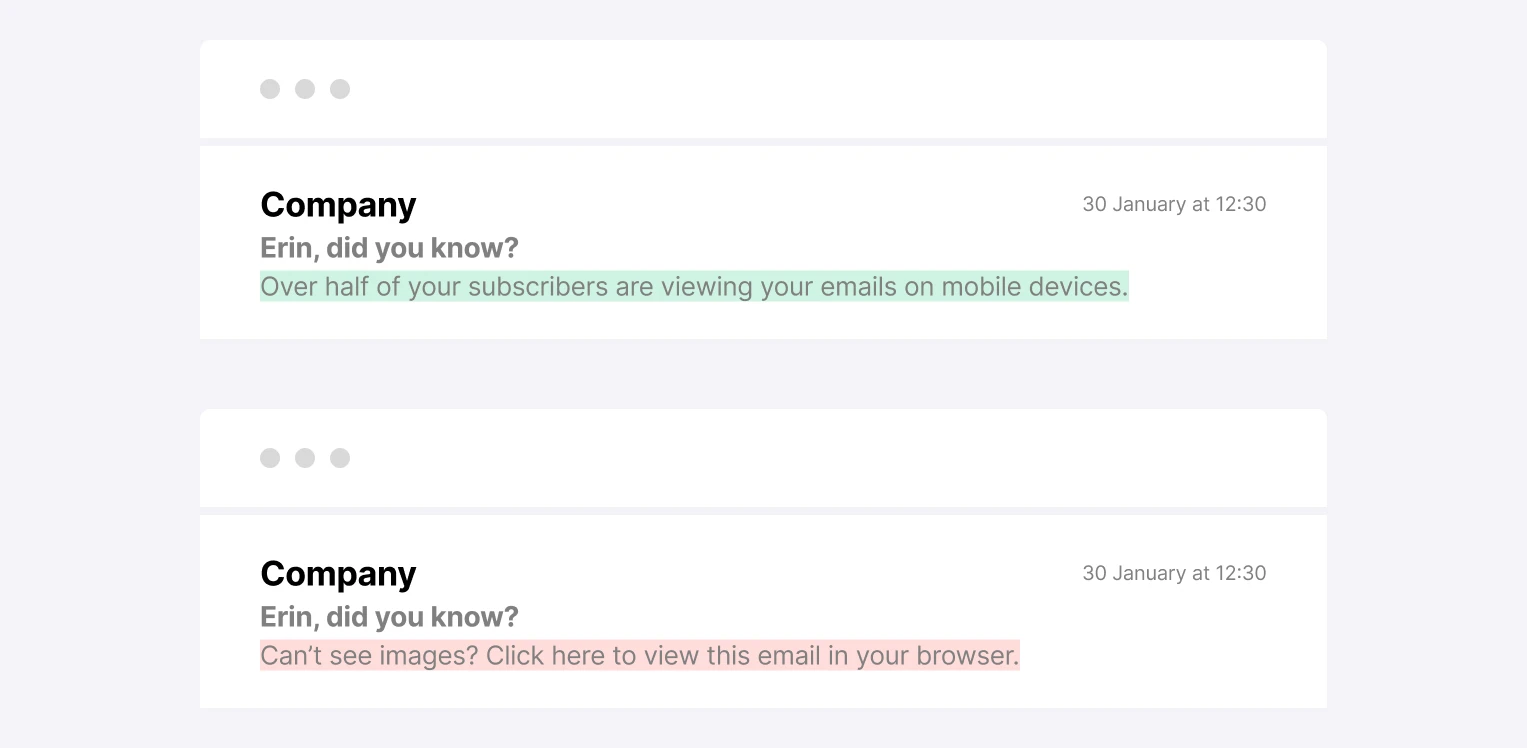
15. Give a command
Sometimes your readers need to be told what to do. Giving them clear direction and a strong call-to-action will actually help them take action. The trick is to give a directive without being too bossy.

16. Test, test and test again
Even if you were to implement all these tips to the letter, there’s no way of knowing that they will all resonate with your audience and improve your email marketing strategy without testing.
Email A/B testing allows you to split your audience and test two different subject lines. This lets you gain valuable insight into what works and what doesn’t, so you can create more effective subject lines in the future.
The best part is, A/B testing doesn’t begin and end with subject lines. You can A/B test preheaders, email body content, sender address and more! Just make sure you only test one element at a time. That way you get a clear idea of which tactics improve performance.
While we’re on the subject…
Each email subject line you create has one sentence, one chance, to make the right impression and get subscribers interested. Much like our new friend Fluffy, if they enjoy the first meeting they’re more likely to be open to the next one. From there you can start building a strong long-term relationship with your subscribers (and no one is at risk of getting scratched).
The email subject line and preheader should work together to build anticipation of your valuable content. To learn more, check out this article where we cover everything you need to know about email preheaders.




